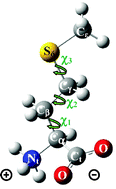Side chain flexibility and protonation states of sulfur atom containing amino acids
Abstract
We present a set of new data allowing elucidation of the energetic, conformational and vibrational features of

* Corresponding authors
a
Groupe de Biophysique Moléculaire, UFR SMBH, Université Paris 13, 74 rue Marcel Cachin, 93017 Bobigny cedex, France
E-mail:
mahmoud.ghomi@univ-paris13.fr
b Université Paris Diderot, Sorbonne Paris Cité, ITODYS, UMR 7086 CNRS, 75013 Paris, France
c Université Pierre et Marie Curie Paris 06, Laboratoire Acides Nucléiques et Biophotonique (FRE 3207), 75252 Paris, France
We present a set of new data allowing elucidation of the energetic, conformational and vibrational features of

 Please wait while we load your content...
Something went wrong. Try again?
Please wait while we load your content...
Something went wrong. Try again?
B. Hernández, F. Pflüger, A. Adenier, S. G. Kruglik and M. Ghomi, Phys. Chem. Chem. Phys., 2011, 13, 17284 DOI: 10.1039/C1CP21054H
To request permission to reproduce material from this article, please go to the Copyright Clearance Center request page.
If you are an author contributing to an RSC publication, you do not need to request permission provided correct acknowledgement is given.
If you are the author of this article, you do not need to request permission to reproduce figures and diagrams provided correct acknowledgement is given. If you want to reproduce the whole article in a third-party publication (excluding your thesis/dissertation for which permission is not required) please go to the Copyright Clearance Center request page.
Read more about how to correctly acknowledge RSC content.
 Fetching data from CrossRef.
Fetching data from CrossRef.
This may take some time to load.
Loading related content
